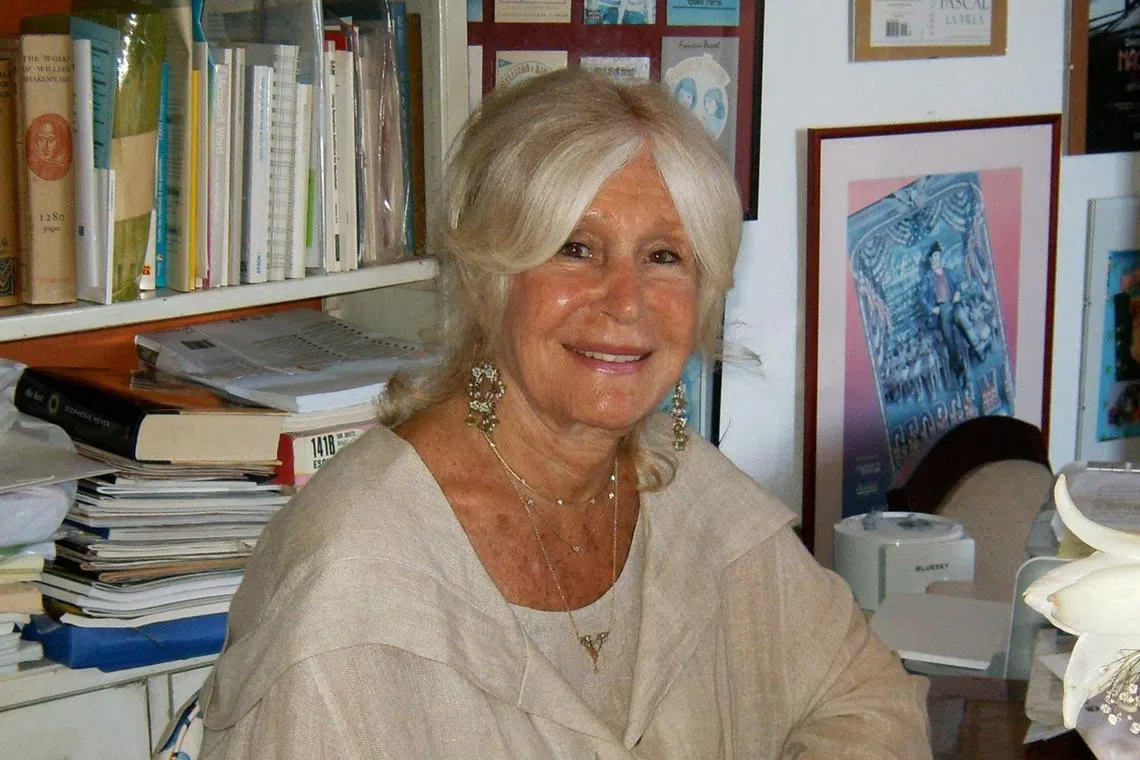US author Francine Pascal, creator of Sweet Valley High book series, dies at 92
Sign up now: Get ST's newsletters delivered to your inbox

Francine Pascal's Sweet Valley series of novels for teenagers debuted in 1983.
PHOTO: FRANCINE PASCAL/FACEBOOK
Follow topic:
NEW YORK – American author Francine Pascal, best known for her long-running and mega-best-selling Sweet Valley High series of young-adult novels, died on July 28 in Manhattan, United States. She was 92.
Her daughter Laurie Wenk-Pascal said the death, at NewYork-Presbyterian Hospital, was caused by lymphoma.
With covers instantly recognisable by their varsity-style lettering and soft-focus illustrations, Sweet Valley High books enraptured a generation of teenage readers with the lives of Elizabeth and Jessica Wakefield, identical twins attending high school in the fictional Los Angeles suburb of Sweet Valley.
The twins are “the most adorable, dazzling 16-year-old girls imaginable”, Pascal told People magazine in 1988.
They, and the books, are also strikingly innocent. Even as the thoughtful Elizabeth and the scheming Jessica clash over boys, friends and spots on the cheerleading team, drugs, alcohol and sex barely permeate the 181 titles in Sweet Valley High, or the scores of others in the spin-offs – and the spin-offs of spin-offs – from the series.
Within a few years of its debut in 1983, Sweet Valley High had taken over the young-adult book market. In January 1986, 18 out of the top 20 books on US bookstore chain B. Dalton’s young-adult bestseller list were Sweet Valley High titles. Taken together, the Sweet Valley universe has sold well over 200 million copies.
That juggernaut revolutionised young-adult publishing. Though there had been no shortage of books for teenage readers – and teenage girls in particular – Pascal recognised their limitless voracity for a compelling narrative and developed a way to feed it.
“There are millions of teenagers that no one in publishing knew existed,” she told The Los Angeles Times in 1986.
Pascal wrote the first 12 books in the series, then worked with a team of writers to keep a steady, rapid publication pace, often a book a month.
She would draft a detailed outline, then hand it to a writer to flesh out while relying on what Pascal called her “bible” – a compendium of descriptions of the personalities, settings and dense web of relationships that defined life in Sweet Valley.
“I can’t have any deviation, no matter how small, because it can impact future stories,” she told her daughter Susan Johansson in an e-mail shortly before her death. “The better writers follow my outlines perfectly.”
Pascal had never been to Southern California when the first books appeared, starting with Double Love, in which the Wakefield twins fight over the same boy, a basketball star named Todd Wilkins.
That debut also introduced the idyllic Sweet Valley world to readers.
“Everything about it was terrific – the gently rolling hills, the quaint downtown area and the fantastic white sand beach only 15 minutes away,” Pascal wrote.
More broadly, those first books acquainted readers from outside Southern California with the Valley Girl aesthetic that would echo through pop culture for decades, shaping speech patterns (uptalking, using “like” as a filler word), clothing and a long list of television shows, movies and books that are impossible to imagine without Pascal’s influence.
Though she wrote several books before starting the Sweet Valley series, including a 1974 non-fiction account of the Patty Hearst trial, Pascal first made her name writing for the soap opera The Young Marrieds (1964 to 1966) with her husband, US playwright and screenwriter John Pascal.
The TV genre’s influence showed in the contours of the Sweet Valley books, with their convoluted, gossip-fuelled story lines, melodramatic plot twists and cliffhanger endings.
Yet, she insisted that the books were, at heart, morality tales – instructing readers on the intricacies of life and illustrating a sense of idealism and wonder that she felt embodied the universal teen experience, whether in urban Queens or sunny Southern California.
“I loved the idea of high school as microcosm of the real world,” she told The Guardian in 2012. “And what I really liked was how it moved things on from Sleeping Beauty-esque romance novels, where the girl had to wait for the hero. This would be girl-driven, very different, I decided – and indeed it is.”
Francine Paula Rubin was born on May 13, 1932, in Manhattan to William and Kate (Dunitz) Rubin and grew up in Jamaica, Queens. Her father was an auctioneer.
After studying journalism at New York University, she worked as a freelance writer for gossipy magazines like True Confessions and Modern Screen and, later, for outlets such as Cosmopolitan and Ladies’ Home Journal.
Her first marriage to Mr Jerome Offenberg ended in divorce in 1963. A year later, she married Pascal, who died at age 48 in 1981.
Both her daughters, Wenk-Pascal and Johansson, are from her first marriage, as was a third, Jamie Stewart, who died in 2008. Francine Pascal, who lived most of her adult life in Midtown Manhattan, is also survived by six grandchildren and five great-grandchildren.
Though some critics panned her books’ utopian settings and fanciful plots, Pascal was unapologetic.
“These books have uncovered a whole population of young girls who were never reading,” she told People. “I don’t know that they’re all going to go on to War And Peace, but we have created readers out of non-readers. If they go on to Harlequin romances, so what? They’re going to read.” NYTIMES

